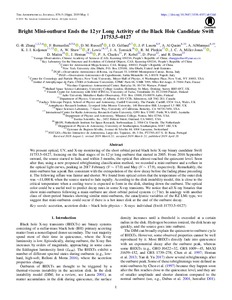| dc.contributor.author | A. Al Qasim | |
| dc.contributor.author | R. Doran | |
| dc.contributor.author | G.-B. Zhang | |
| dc.contributor.author | P. Kobel | |
| dc.contributor.author | P. A. Charles | |
| dc.contributor.author | D. Perez | |
| dc.contributor.author | F. Bernardini | |
| dc.contributor.author | J. Homan | |
| dc.contributor.author | D. M. Russell | |
| dc.contributor.author | K. I. I. Koljonen | |
| dc.contributor.author | J. A. Tomsick | |
| dc.contributor.author | J. D. Gelfand | |
| dc.contributor.author | A. W. Shaw | |
| dc.contributor.author | D. Maitra | |
| dc.contributor.author | A. AlMannaei | |
| dc.contributor.author | J.-P. Lasota | |
| dc.contributor.author | J. C. A. Miller-Jones | |
| dc.contributor.author | F. Lewis | |
| dc.contributor.author | R. M. Plotkin | |
| dc.date.accessioned | 2022-10-27T12:23:36Z | |
| dc.date.available | 2022-10-27T12:23:36Z | |
| dc.identifier.uri | https://www.utupub.fi/handle/10024/158292 | |
| dc.description.abstract | We present optical, UV, and X-ray monitoring of the short orbital period black hole X-ray binary candidate Swift J1753.5-0127, focusing on the final stages of its 12 yr long outburst that started in 2005. From 2016 September onward, the source started to fade, and within 3 months, the optical flux almost reached the quiescent level. Soon after that, using a new proposed rebrightening classification method, we recorded a mini-outburst and a reflare in the optical light curves, peaking in 2017 February (V similar to 17.0) and May (V similar to 17.9), respectively. Remarkably, the mini-outburst has a peak flux consistent with the extrapolation of the slow decay before the fading phase preceding it. The following reflare was fainter and shorter. We found from optical colors that the temperature of the outer disk was similar to 11,000 K when the source started to fade rapidly. According to the disk instability model, this is close to the critical temperature when a cooling wave is expected to form in the disk, shutting down the outburst. The optical color could be a useful tool to predict decay rates in some X-ray transients. We notice that all X-ray binaries that show mini-outbursts following a main outburst are short orbital period systems (<7 hr). In analogy with another class of short-period binaries showing similar mini-outbursts, the cataclysmic variables of the RZ LMi type, we suggest that mini-outbursts could occur if there is a hot inner disk at the end of the outburst decay. | |
| dc.language.iso | en | |
| dc.publisher | IOP PUBLISHING LTD | |
| dc.title | Bright Mini-outburst Ends the 12 yr Long Activity of the Black Hole Candidate Swift J1753.5-0127 | |
| dc.identifier.urn | URN:NBN:fi-fe2021042823527 | |
| dc.relation.volume | 876 | |
| dc.contributor.organization | fi=Suomen ESO-keskus, yhteiset|en=Finnish Centre for Astronomy with ESO - FINCA| | |
| dc.contributor.organization-code | 2609700 | |
| dc.converis.publication-id | 40704123 | |
| dc.converis.url | https://research.utu.fi/converis/portal/Publication/40704123 | |
| dc.identifier.eissn | 1538-4357 | |
| dc.identifier.jour-issn | 0004-637X | |
| dc.okm.affiliatedauthor | Koljonen, Karri | |
| dc.okm.discipline | 115 Avaruustieteet ja tähtitiede | fi_FI |
| dc.okm.discipline | 115 Astronomy and space science | en_GB |
| dc.okm.internationalcopublication | international co-publication | |
| dc.okm.internationality | International publication | |
| dc.okm.type | Journal article | |
| dc.publisher.country | United States | en_GB |
| dc.publisher.country | Yhdysvallat (USA) | fi_FI |
| dc.publisher.country-code | US | |
| dc.relation.articlenumber | ARTN 5 | |
| dc.relation.doi | 10.3847/1538-4357/ab12dd | |
| dc.relation.ispartofjournal | Astrophysical Journal | |
| dc.relation.issue | 1 | |
| dc.year.issued | 2019 | |
